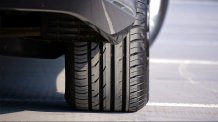Articles

The research will aim to quantify tyre particle concentrations at their points of entry to the marine environment.
Project aims to reveal the fate of tyre particles in the marine environment
The new study aims to assess an until now hidden form of marine litter and show the effects it could have on our seas
Tyre particles are believed to transfer in large quantities from vehicles into our rivers and oceans. However, their precise fate – and the impact they have – remains something of a mystery.
Now a three-year project funded by the Natural Environment Research Council aims to assess this until now hidden form of marine litter, and show the effects it could have on our seas and the species within them.
Bringing together the Universities of Plymouth, Exeter and Newcastle, together with Plymouth Marine Laboratory, the research will aim to quantify tyre particle concentrations at their points of entry to the marine environment.
It will then explore how far they can spread, and any harm they might cause, by measuring concentrations in the sediment, water and biota up to 15km from the shoreline.
The project – Lost at Sea: where are all the tyre particles? (TYRE-LOSS) – will build on a major government-funded study published earlier this year, and also led by the University of Plymouth and Newcastle University.
It indicated up to 100million m² of the UK’s river network – and more than 50million m² of estuarine and coastal waters – at risk of contamination by tyre particles.
The new research will use techniques developed through that project to construct and validate mathematical models describing the dispersal of tyre particles in inshore waters.
This information will then be used to establish the potential for any associated risks to marine life at environmentally relevant concentrations.
As well as uniting some of the world’s leading experts in microplastics, environmental chemistry, coastal dynamics and ecotoxicology, the project is being supported by an advisory group including policy makers, representatives of the tyre, automobile, plastics and water industries, and environmental charities.
Professor Richard Thompson OBE FRS, Head of the International Marine Litter Research Unit at the University of Plymouth and Principal Investigator on the TYRE-LOSS project said:
“Over many years, we have demonstrated that the sources and impacts of microplastics are incredibly varied and complex. In comparison to other sources, relatively little is still known about the precise quantities of tyre particles in the marine environment and the effects they have once there.
“This project is important to further our understanding, and brings together partners with whom we have worked previously on ground-breaking research into the causes and effects of marine litter. The advisory group also ensures that our evidence can be used to help guide solutions as it is only by working in tandem with industry and policy makers that we can truly address the global crisis of plastic pollution.”
Dr Geoff Abbott, Reader in the School of Natural and Environmental Sciences at Newcastle University, is directing the analytical geochemistry in the TYRE-LOSS project. He said: “Synthetic rubber, a plastic polymer, is a major component of tyres today. A substantial quantity of tyre wear is potentially a major contributor to microplastic pollution in the marine environment. A highly sensitive instrument called a mass spectrometer is being used at Newcastle University which can detect and measure even the smallest amounts of these microplastics in the water, sediment and marine life. The likelihood of any associated risks to marine life can then be established."
Professor Tamara Galloway OBE, of the Global Systems Institute at the University of Exeter, said: “This project will be a fantastic opportunity to take a systematic look at tyre pollution and how it affects the marine environment.”
Dr Penelope Lindeque, from Plymouth Marine Laboratory, added: “We are delighted to be part of this timely and urgent research, working with colleagues from Plymouth, Newcastle and Exeter Universities. Our role will be to use mathematical models to determine where the tyre particles will disperse and accumulate once they have entered the marine environment. Once we understand where the tyre particles go in the marine environment, we will undertake laboratory-based experiments to determine the impact these particles, and the associated hazardous chemicals they contain, may have on important marine animals.”
Date: 1 October 2020
